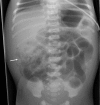Recognising serious umbilical cord anomalies
- PMID: 24285812
- PMCID: PMC3847477
- DOI: 10.1136/bcr-2013-201663
Recognising serious umbilical cord anomalies
Abstract
Umbilical vessel catheterisation is a common intervention in neonatal care. Many complications are recognised, some of which are life-threatening. We report the case of a term neonate who was compromised at birth following antepartum haemorrhage with evidence of multiorgan ischaemic injury. Following resuscitation and umbilical vessel catheterisation, she developed pneumoperitoneum. At laparotomy, a patent vitellointestinal duct was identified and resected. Intestinal perforation was found in the duct wall, most plausibly explained by the unintentional catheterisation of the duct via the umbilicus. Learning to recognise umbilical cord anomalies, such as patent vitellointestinal duct, can be simple and could prevent potentially serious complications.
Figures



References
-
- http://www.rcpch.ac.uk/training-examinations-professional-development/qu... (accessed Jun 2013)
-
- http://www.alsg.org/uk/APLS (accessed Jun 2013)
-
- http://www.rcm.org.uk/midwives/features/how-to-perform-an-examination-of... (accessed Jun 2013)
-
- Menezes M, Tareen F, Saeed A, et al. Symptomatic Meckel's diverticulum in children: a 16-year review. Pediatr Surg Int 2008;2013:575–7 - PubMed
-
- Snyder CL. Current management of umbilical abnormalities and related anomalies. Semin Pediatr Surg 2007;2013:41–9 - PubMed
Publication types
MeSH terms
LinkOut - more resources
Full Text Sources
Other Literature Sources
